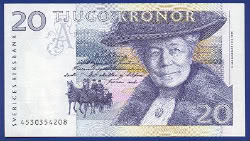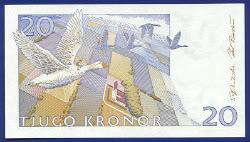beer good
Well-Known Member
Well, my summer project of reading Swedish classics I should have read decades ago is moseying along. Let's see if we can get at least some interest going for a writer who seems to be largely forgotten outside our borders.
Selma Ottilia Lovisa Lagerlöf (1858-1940) was and remains one of Sweden's most popular authors, partly thanks to the children's book Nils Holgerssons underbara resa genom Sverige (The Wonderful Adventures of Nils, 1907) but also for novels like Gösta Berlings saga (Gösta Berling's Saga, 1891), Kejsaren av Portugalien (The Emperor of Portugalia, 1914) and Jerusalem (Jerusalem, 1902). She was the first woman to win the Nobel Prize for Literature (1909) and the first woman to be elected into the Swedish Academy (1914). Oh, and she's on the 20-kronor banknote along with Nils and Gösta.


Most of her stories are set in her home province of Värmland, at the time a pretty rural place consisting largely of forests, small farms, and a few great mansions. Like other writers from the same area, notably her friend the poet Gustaf Fröding, she shows a mix of influences echoing both 19th century romanticism, early modernism (though she didn't care for strict realism), old folk tales and religious writings; the beginnings of modern Sweden, suffused by the myths and stories that built it.
She was also active in the women's suffragette movement, one of the founders of Sweden's liberal party, as well as an outspoken critic of rising national socialism in Germany. At the start of World War II, she sent her Nobel Prize medal and gold medal from the Swedish Academy to the government of Finland to help raise money to fight the Soviet Union. The Finnish government was so touched that it raised the necessary money by other means and returned her medal to her.
Many of her books have been turned into plays and movies, starting as early as in the silent film age, and continuing to this day.
Selma Ottilia Lovisa Lagerlöf (1858-1940) was and remains one of Sweden's most popular authors, partly thanks to the children's book Nils Holgerssons underbara resa genom Sverige (The Wonderful Adventures of Nils, 1907) but also for novels like Gösta Berlings saga (Gösta Berling's Saga, 1891), Kejsaren av Portugalien (The Emperor of Portugalia, 1914) and Jerusalem (Jerusalem, 1902). She was the first woman to win the Nobel Prize for Literature (1909) and the first woman to be elected into the Swedish Academy (1914). Oh, and she's on the 20-kronor banknote along with Nils and Gösta.


Most of her stories are set in her home province of Värmland, at the time a pretty rural place consisting largely of forests, small farms, and a few great mansions. Like other writers from the same area, notably her friend the poet Gustaf Fröding, she shows a mix of influences echoing both 19th century romanticism, early modernism (though she didn't care for strict realism), old folk tales and religious writings; the beginnings of modern Sweden, suffused by the myths and stories that built it.
She was also active in the women's suffragette movement, one of the founders of Sweden's liberal party, as well as an outspoken critic of rising national socialism in Germany. At the start of World War II, she sent her Nobel Prize medal and gold medal from the Swedish Academy to the government of Finland to help raise money to fight the Soviet Union. The Finnish government was so touched that it raised the necessary money by other means and returned her medal to her.
Many of her books have been turned into plays and movies, starting as early as in the silent film age, and continuing to this day.




 +
+